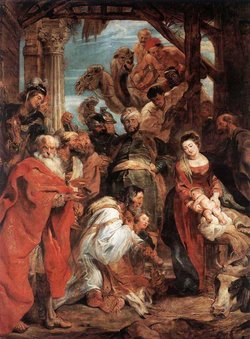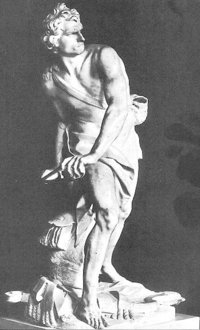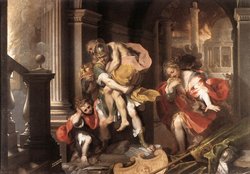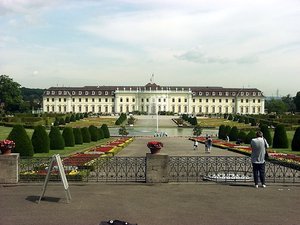Baroque
|
|

In arts, the Baroque (or baroque) is both a period and the style that dominated it. Baroque style used exaggerated motion and clear, easily interpreted detail to produce drama, tension, exuberance, and grandeur from sculpture, painting, literature, and music. The style started around 1600 in Rome, Italy and spread to most of Europe. In music, the Baroque applies to the final period of dominance of imitative counterpoint.
(The name adapted a French adjective that is derived from the Portuguese noun "barrucco"; both described a pearl of irregular shape. Some confusion can occur in using for the period and style the lower-cased version "baroque", which can instead mean merely "elaborate" (or especially "overly elaborate") without implying connection to the period.)
The popularity and success of the "Baroque" was encouraged by the Catholic Church when it decided that the drama of the Baroque artists' style could communicate religious themes in direct and emotional involvement. The secular aristocracy also saw the dramatic style of Baroque architecture and art as a means of impressing visitors and would-be competitors. Baroque palaces are built round an entrance sequence of courts, anterooms, grand staircases, and reception rooms of sequentially increasing magnificence. Many forms of art, music, architecture, and literature inspired each other in the "Baroque" cultural movement.
| Contents |
Evolution of the Baroque
The Baroque originated around 1600. The canon promulgated at the Council of Trent (1545–63), by which the Roman Catholic Church addressed the representational arts by demanding that paintings and sculptures in church contexts should speak to the illiterate rather than to the well-informed, is customarily offered as an inspiration of the Baroque, which appeared, however, a generation later. This turn toward a populist conception of the function of ecclesiastical art is seen by many art historians as driving the innovations of Caravaggio and the Carracci brothers, all of whom were working (and competing for commissions) in Rome around 1600.
The appeal of Baroque style turned consciously from the witty, intellectual qualities of 16th century Mannerist art to a visceral appeal aimed at the senses. It employed an iconography that was direct, simple, obvious, and dramatic (see the Prometheus sculpture below). Baroque art drew on certain broad and heroic tendencies in Annibale Caracci and his circle, and found inspiration in other artists like Correggio and Caravaggio and Federico Barocci, nowadays sometimes termed 'proto-Baroque'.

Germinal ideas of the Baroque can also be found in the work of Michelangelo.
Some general parallels in music make the expression "Baroque music" useful: there are contrasting phrase lengths, harmony and counterpoint have ousted polyphony, and orchestral color makes a stronger appearance. See the entry Baroque music. Similar fascination with simple, strong, dramatic expression in poetry, where clear, broad syncopated rhythms replaced the enknotted elaborated metaphysical similes employed by Mannerists such as John Donne and imagery that was strongly influenced by visual developments in painting, can be sensed in John Milton's Paradise Lost, a Baroque epic.
Though Baroque was superseded in many centers by the Rococo style, beginning in France in the late 1720s, especially for interiors, paintings and the decorative arts, Baroque architecture remained a viable style until the advent of Neoclassicism in the later 18th century. See the Neapolitan palace of Caserta, a Baroque palace (though in a chaste exterior) that was not even begun until 1752. Critics have given up talking about a "Baroque period".
In paintings, Baroque gestures are broader than Mannerist gestures: less ambiguous, less arcane and mysterious, more like the stage gestures of opera, a major Baroque artform. Baroque poses depend on contrapposto ("counterpoise"), the tension within the figures that moves the planes of shoulders and hips in counterdirections. See Benini's David (below, left).
The dryer, chastened, less dramatic and coloristic, later stages of 18th century Baroque architectural style are often seen as a separate Late Baroque manifestation. See the entry Claude Perrault. Academic characteristics in the neo-Palladian architectural style, epitomized by William Kent, are a parallel development in Britain and the British colonies: within doors, Kent's furniture designs are vividly influenced by the Baroque furniture of Rome and Genoa, hieratic tectonic sculptural elements meant never to be moved from their positions completing the wall elevation. Baroque is a style of unity imposed upon rich and massy detail.
The Baroque was defined by Heinrich Wölfflin as the age where the oval replaced the circle as the center of composition, that centralization replaced balance, and that coloristic and "painterly" effects began to become more prominent. Art historians, often Protestant ones, have traditionally emphasized that the Baroque style evolved during a time in which the Roman Catholic Church had to react against the many revolutionary cultural movements that produced a new science and new forms of religion— Reformation. It has been said that the monumental Baroque is a style that could give the Papacy, like secular absolute monarchies, a formal, imposing way of expression that could restore its prestige, at the point of becoming somehow symbolic of the Catholic Reformation. Whether this is the case or not, it was successfully developed in Rome, where Baroque architecture widely renewed the central areas with perhaps the most important urbanistic revision.
Baroque visual art

Main article: Baroque art
A defining statement of what Baroque signifies in painting is provided by the series of paintings executed by Peter Paul Rubens for Marie de Medici at the Luxembourg Palace in Paris (now at the Louvre) [1] (http://www.students.sbc.edu/vandergriff04/mariedemedici.html), in which a Catholic painter satisfied a Catholic patron: Baroque-era conceptions of monarchy, iconography, handling of paint, and compositions as well as the depiction of space and movement. Another frequently cited work of Baroque art is Bernini's "Saint Theresa in ecstasy" for the Cornaro chapel in S. Maria della Vittoria, which brings together multiple arts, including opera [2] (http://www.boglewood.com/cornaro/xteresa.html).
The later baroque style gives way gradually to Rococo. A comparison with Rococo, will help define Baroque by contrast.
Baroque sculpture
In Baroque sculpture, groups of figures assumed new importance, and there was a dynamic movement and energy of human forms— they spiralled around an empty central vortex, or reached outwards into the surrounding space. For the first time, Baroque sculpture often had multiple ideal viewing angles. The characteristic Baroque sculpture added extra-sculptural elements, for example, concealed lighting, or water fountains.
The architecture, sculpture and fountains of Bernini (1598–1680) give highly-charged characteristics of Baroque style. Bernini was undoubtedly the most important sculptor of the Baroque period. He approached Michelangelo in his omnicompetence: Bernini sculpted, worked as an architect, painted, wrote plays, and staged spectacles. In the late 20th century Bernini was most valued for his sculpture, both for his virtuosity in carving marble and his ability to create figures that combine the physical and the spiritual. He was also a fine sculptor of bust portraits in high demand among the powerful.
Bernini's Cornaro chapel: the complete work of art
BerniniEcstacy.jpg
A good example of Bernini's work that helps us understand the Baroque is his St. Theresa in Ecstasy (1645–52), created for the Cornaro Chapel of the church of Santa Maria della Vittoria, Rome. Bernini designed the entire chapel, a subsidiary space along the side of the church, for the Cornaro family.
He had, in essence, a brick box shaped something like a proscenium stage space with which to work. He created a main statue as the focal point of the chapel, surrounded the monochromatic marble statue (a soft white) with a polychromatic marble architectural framing concealing a window to light the statue from above, and placed shallow relief sculpture figure-groups of the Cornaro family in opera boxes along the two side walls of the chapel. The setting places the viewer as a spectator in front of the statue with the Cornaro family leaning out of their box seats and craning forward to see the mystical ecstasy of the saint. The statue of St. Theresa of Avila is highly idealized in detail and in an imaginary setting. St. Theresa of Avila, one of the most popular saints of the Catholic Reformation, wrote narratives of her mystical experiences aimed at the nuns of her Carmelite Order; these writings had become popular reading among lay people interested in pursuing spirituality. She once described the love of God as piercing her heart like a burning arrow. Bernini literalizes this image by placing St. Theresa on a cloud in a reclining pose; what can only be described as a Cupid figure holds a golden arrow (the arrow is made of metal) and smiles down at her. The angelic figure is not preparing to plunge the arrow into her heart— rather, he has withdrawn it. St. Theresa's face reflects not the anticipation of ecstasy, but her current fulfillment, which can only be described as orgasmic.
The blending of religious and erotic was intensely offensive to both neoclassical restraint and, later on, to Victorian prudishness; it is part of the genius of the Baroque. Bernini, who shows every sign in his writings of being a convinced and conventionally devout Catholic, is not attempting to satirize the experience of a virgin who lived a life of chastity, but rather reflects a complex truth about religious experience— that it is an experience that takes place in the body. Theresa described her bodily reaction to spiritual enlightenment in a language of ecstasy used by many mystics, and Bernini did her the favor of taking her seriously.
The Cornaro family promotes itself discreetly in this chapel; they are represented visually, but are placed on the sides of the chapel, witnessing the event from balconies. As in an opera house, the Cornaro have a privileged position in respect to the viewer, in their private reserve, closer to the saint; the viewer, however, has a better view from the front. They attach their name to the chapel, but St. Theresa is the focus. It is a private chapel in the sense that no one could say mass on the altar beneath the statue (in the 17th century and probably through the 19th) without permission from the family, but the only thing that divides the viewer from the image is the altar rail. The spectacle functions both as a demonstration of mysticism and as a piece of family pride.
Baroque architecture
Stift_melk_001_2004.jpg
Main article: Baroque architecture
In Baroque architecture, new emphasis was placed on bold massing, colonnades, domes, light-and-shade (chiaroscuro), 'painterly' color effects, and the bold play of volume and void. In interiors, Baroque movement around and through a void informed monumental staircases that had no parallel in previous architecture. The other Baroque innovation in worldly interiors was the state apartment, a processional sequence of increasingly rich interiors that culminated in a presence chamber or throne room or a state bedroom. The sequence of monumental stair followed by state apartment was copied in smaller scale everywhere in aristocratic dwellings of any pretensions.
Baroque architecture was taken up with enthusiasm in central Germany (see e.g. Ludwigsburg Palace and Zwinger Dresden) and Austria. In England the culmination of Baroque architecture was embodied in work by Sir Christopher Wren, Sir John Vanbrugh and Nicholas Hawksmoor, from ca. 1660 to ca. 1725. Many examples of Baroque architecture and town planning are found in other European towns, and in the Spanish Americas. Town planning of this period featured radiating avenues intersecting in squares, which took cues from Baroque garden plans.
For examples see: List of examples of typical Baroque architecture

Neo-Baroque architecture
Baroque theater and dance
In theater, the elaborate conceits, multiplicity of plot turns, and variety of situations characteristic of Mannerism (Shakespeare's tragedies, for instance) are superseded by opera, which drew together all the arts in a unified whole.
Dance was popular in the Baroque era.
Baroque literature and philosophy
Baroque actually expressed new values, which often are summarised in the use of metaphor and allegory, widely found in Baroque literature, and in the research for the "maraviglia" (wonder, astonishment — as in Marinism), the use of artifices. If Mannerism was a first breach with Renaissance, Baroque was an opposed language. It represented the evidence of the crisis of Renaissance neoclassical schemes— the psychological pain of Man, disbanded after the Copernican and the Lutheran revolutions, in search of solid anchors, in search of a proof of an ultimate human power, was to be found in both the art and architecture of the Baroque period. A relevant part of works was made on religious themes, since the Roman Church was the main "customer."
Virtuosity was researched by artists (and the Virtuoso became a common figure in any art,) together with realism and care for details (some talk of a typical "intricacy.")
Not without a certain correctness, it is said that the privilege given to external forms had to compensate and balance the lack of contents that has been observed in many Baroque works: Marino's "Maraviglia", for example, is practically made of the pure, mere form. Fantasy and imagination should be evoked in the spectator, in the reader, in the listener. All was focused around the individual Man, as a straight relationship between the artist, or directly the art and its user, its client. Art is then less distant from user, more directly approaching him, solving the cultural gap that used to keep art and user reciprocally far, by Maraviglia. But the increased attention to the individual, also created in these schemes some important genres like the Romanzo (novel) and let popular or local forms of art, especially dialectal literature, to be put into evidence. In Italy this movement toward the single individual (that some define a "cultural descent", while others indicate it was a possible cause for the classical opposition to Baroque) caused Latin to be definitely replaced by Italian.
In English literature, the metaphysical poets represent a closely related movement; their poetry likewise sought unusual metaphors, which they then examined in often extensive detail. Their verse also manifests a taste for paradox, and deliberately inventive and unusual turns of phrase.
Baroque music
Main article: Baroque music
The term Baroque also is used to designate the style of music composed during a period that overlaps with that of Baroque art, but usually covers a slightly later period. J.S. Bach and G.F. Handel are its leading lights; see Baroque music for discussion. It is an interesting question to what extent Baroque music shares aesthetic principles with the visual and literary arts of the Baroque period. A fairly clear, shared element is a love of ornamentation, and it is perhaps significant that the role of ornament was greatly diminished in both music and architecture as the Baroque gave way to the Classical period. It should be noted that the application of the term to music is a relatively recent development: the first use of the word to apply to music was only in 1919, by Curt Sachs, and it was not until 1940 that it was first used in English (in a published article by Manfred Bukofzer); even as late as 1960 there was still considerable dispute in academic circles over whether music as diverse as that by Peri, Couperin and J.S. Bach could be meaningfully bundled together with a single term.
Examples of typical Baroque music
- Johann Sebastian Bach (1685–1750), The Art of Fugue
- Antonio Vivaldi (1678–1741), L'Estro Armonico
- Domenico Scarlatti (1685–1757), Sonatas for Cembalo or Harpsichord
- Georg Friedrich Handel (1685–1759), Water Music Suite for Orchestra
- Georg Philipp Telemann (1681 - 1767), Der Tag des Gerichts The Day of Judgement (1762)
The term "Baroque"
The word "Baroque", like most period or stylistic designations, was invented by later critics rather than practitioners of the arts in the 17th and early 18th centuries. It is a French translation of the Italian word "Barocco". Some authors believe it comes from the Portuguese "Barroco" (meaning an irregular pearl, or false jewel—notably, an ancient similar word, "Barlocco" or "Brillocco", is used in Roman dialect for the same meaning—and natural pearls that deviate from the usual, regular forms so they do not have an axis of rotation are known as "baroque pearls"). Alternatively, it may derive from the now obsolete Italian "Baroco" (meaning, in logical Scholastica, a syllogism with weak content). A common definition, before the term Barocco was used, called this genre simply the style of The Flying Forms.
The term "Baroque" was initially used with a derogatory meaning, to underline the excesses of its emphasis, of its eccentric redundancy, its noisy abundance of details, as opposed to the clearer and sober rationality of the Renaissance. It was first rehabilitated by the Swiss-born art historian, Heinrich Wölfflin (1864–1945) in his Renaissance und Barock (1888); Wölfflin identified the Baroque as "movement imported into mass," an art antithetic to Renaissance art. He did not make the distinctions between Mannerism and Baroque that modern writers do, and he ignored the later phase, the academic Baroque that lasted into the 18th century. Writers in French and English did not begin to treat Baroque as a respectable study until Wölfflin's influence had made German scholarship pre-eminent.
In modern usage, the term "Baroque" may still be used, usually pejoratively, to describe works of art, craft, or design that are thought to have excessive ornamentation or complexity of line, or, as a synonym for "Byzantine", to describe literature, computer programs, contracts, or laws that are thought to be excessively complex, indirect, or obscure in language, to the extent of concealing or confusing their meaning. A "Baroque fear" is deeply felt, but utterly beyond daily reality.
External links
- Dictionary of the History of Ideas: (http://etext.lib.virginia.edu/cgi-local/DHI/dhi.cgi?id=dv1-27) Baroque in literature
- Webmuseum Paris (http://www.ibiblio.org/wm/paint/glo/baroque/)
Further reading
- Heinrich Wölfflin, 1964. Renaissance and Baroque (Reprinted 1984; originally published in German, 1888) The classic study.
- Michael Kitson, 1966. The Age of Baroque
- John Rupert Martin, 1977. Baroque A more detailed survey.
- Germain Bazin, 1964. Baroque and Rococo, (Originally published in French; reprinted as Baroque and Rococo Art, 1974)bg:Барок
ca:Barroc da:Barok de:Barock es:Barroco eo:Baroko fr:Baroque it:Barocco he:בארוק ja:バロック hu:Barokk nl:Barok nn:Barokken pl:Barok pt:Barroco ru:Барокко sk:Barok sr:Барок fi:Barokki sv:Barock uk:Бароко zh:巴洛克

